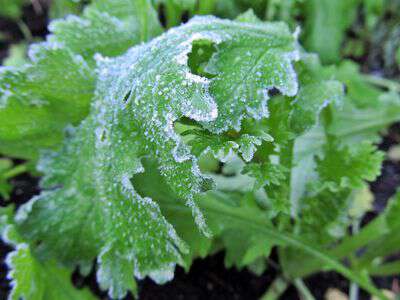
While cultivated collards, turnip greens, and mustard varieties have been known to escape or naturalize and grow wild in old garden plots, it was common practice to plant them in late summer and early fall with other cool weather crops. People also planted late cabbage and turnips for storing through the winter, and the fall garden assured them of a good supply of fresh greens after the warm-weather crops finished coming in.
Esco Pitts elaborates: “For a fall crop, we planted turnips and cabbage in September. Sometimes we’d put out late multiplying onions in the fall (around September) and have onions all winter. We buried the turnips along with the cabbage to keep them through the winter. Usually, my mother planted [collards] in the fall of the year. Around the latter part of July or the first of August, she’d sow a collard bed, and when they come up a good size to transplant, she’d have a row in the garden. Collards are not much good till the frost bites them—it makes them better to eat.”
—The Foxfire Book of Appalachian Cookery
My winter greens have all poked their small heads through the dirt and are reaching for the sunlight.
Last night’s video: Playing the Banjo in Appalachia | Talking Traditional Appalachian Music with Annie Fain Barralon
Subscribe for FREE and get a daily dose of Appalachia in your inbox


I’ve planted carrots, radishes and lettuce to have for a fall garden, and they are sprouting up real well. I’m still harvesting green beans, peppers, tomatoes, and okra and hope to have some eggplant before we have our 1st frost here. We also didn’t get our garden out until June, which is about a month later than I normally plant, but that’s another story. I may plant some turnips so that we can have some greens now and in the early spring. I enjoy the fall season!
Frost reduces the bitterness form turnip greens also and makes them much sweeter.
My custom blend 50%mustard 25%turnip and 25%kale is up. Hoping Mr. Ground Hog leaves them alone. I actually give most of them away but I like a share. I planted spinach too but I very much suspect the seed is too old.
There is just something satisfying about having something in the garden to go harvest when most everything is bare and brown. Today is dreary skies here and makes one think of beef stew, chili or vegetable soup.
A big pot of collards cooked down proper, along with fresh, hot cornbread and butter makes a mighty fine meal.
I can remember my Grandmother digging holes alond the edge of the garden nearest the house, lining the hole with straw and burying cabbage upside down, covered with more straw, then dirt. This was winter storage. As best I recall they were burried with the root up. It also seems to me that she burried something else but now I don’t recall what it was.
At that time people had a number of ways to keep fresh garden food as long as possible, they had to in order to have food to eat through the winter. They counld’t run to the grocery like we do!
Yes mam ms. Tipper, love the fall gardens which we are running behind on here on the homestead. Definitely more pleasant to work and harvest due to the season of fall. We love collards to and we’ve always been told the same thing about the frost making them much better to eat and have found this to be true. Love reading all your stories & shared info! GOD Bless Y’all. Pastor Lon
Nothing better than walking outside to the garden and cutting a head of collards to cook when there is a good frost of them. The frost makes them sweeter as I was always told.
Fall gardens are just as vital as summer gardens.